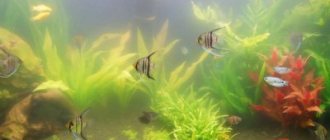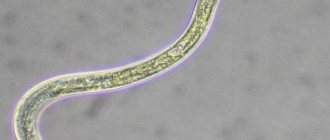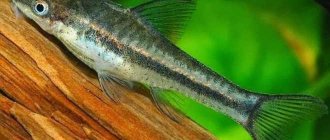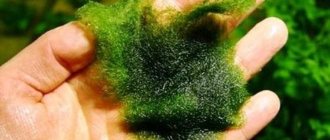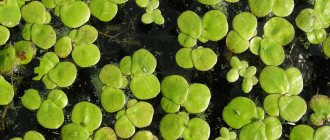Factors affecting how many times replacement is required
How often you need to change the water in the aquarium is influenced by a number of factors:
Aquarium volume . The larger the displacement, the less often you need to change the water.- Number of fish . The greater the “population density”, the shorter the intervals between procedures.
- Type of fish . For example, bettas are very sensitive to the level of pollution in the aquarium; labyrinth fish feel quite comfortable in muddy water.
- Presence of snails . The more of them, the worse for water quality. Many species clean the walls of the aquarium and the soil, but the volume of their metabolic products is disproportionate to the benefits.
- Presence of algae . If there is “greenery”, fresh water is needed less often (but, of course, within reasonable limits - there is no need to turn the aquarium into an impenetrable “jungle”).
- Filtration and aeration systems . The better they purify the water and saturate it with oxygen, the less often it needs to be changed. The type of filter (biological, mechanical, chemical, combined) is not important.
- Temperature . The warmer the water, the faster it sours, and fresh water is required.
- Feeding regimen . If you overfeed fish, excess food settles to the bottom, begins to rot, and water quality deteriorates faster. The same thing applies if you use not special store-bought food, but, for example, bread crumbs or raw meat.
- The quality of the water itself . Most often, its replacement is required when the content of iron and lime is high.
How often should you change the water in your aquarium? and how often should it be completely cleaned? volume 50 liters
Katya Karishkina
Once the aquarium is planted and stocked with fish, the hobbyist should strive to maintain it. It has a stable mode. For the normal development of fish and the prevention of a number of diseases, a certain chemical composition and biological balance are required in the water, maintained over many years. Adding water should be done as it evaporates, cleaning the glass and the soil of the aquarium only partially, no more than 1/5 - 1/3 of the volume of the aquarium. Moreover, even a partial replacement of water should not dramatically change both its gas and salt composition. In aquarium fish farming, a complete replacement of old water is extremely rare. Even with massive fish deaths, it is not completely changed. When completely replacing water, you must be sure that the new water meets all the hydrochemical parameters necessary for the existing fish species. Completely change the water in the aquarium in exceptional cases: when unwanted microorganisms are introduced, fungal mucus appears, rapid flowering of water that does not stop when the aquarium is temporarily darkened, and when the soil is highly contaminated. Plants suffer from a complete change of water: leaves become discolored and die prematurely. If the aquarium is biologically properly populated, then plants, fish and bacteria in the soil and water can replace a good filter. The widespread opinion among novice aquarists about the need for frequent water changes as a prerequisite for the normal maintenance of exotic fish is deeply erroneous. Frequent changes of water in the aquarium can cause illness and even death of fish. In most cases, water changes - although regular 1/5 aquarium water changes are always advisable - do not have the life stage of an indoor tank. This life in an aquarium, depending on our skill and desire, can last from several days to 10 - 15 years. What does that require? Replacing water by 1/5, to a certain extent, of course, (adding non-living tap water) will shake the equilibrium state of the environment, but after a day or two it will be restored. The larger the aquarium, the greater its resistance to our inept interventions. Replacing half of the environment will disrupt the equilibrium stability, some fish and plants may die, but after a week the other homeostatic properties of the environment will be restored again. Replacing all the water with tap water can completely destroy the environment, and everything will have to start over. If you decide to start an aquarium, and have never dealt with one before, but want to arrange everything slowly and somehow, start with a small reservoir of 100-200 liters. It is just as easy to establish biological balance in it, to form a living habitat, as in a small one, and it will be much more difficult to destroy it through inept actions than in an aquarium with a capacity of 20-30 liters. In an aquarium we do not keep aquatic animals and plants, but an aquatic habitat, and the main task of the aquarist is to maintain a balanced, healthy state of this particular environment, and not its individual inhabitants, because if the environment is healthy, then the inhabitants of this environment will be well . The habitat during its formation (when plants are planted in the ground, and a week after that the first fish are released) is extremely unstable, therefore interfering with the operation of the aquarium at this time is strictly prohibited. What do we have to do? You cannot change the water for two months: what is the point of bringing in sterile tap water instead of semi-tap water, which is just turning into residential water? In a large aquarium, changing the water will slow down the formation of the habitat, but in a small aquarium this intervention will cause a disaster and everything will have to start all over again. After two to three months, the emerging aquatic habitat in the aquarium will enter its juvenile stage. From this moment until the aquarium is completely rebuilt, you need to start replacing 1/5 of the water volume every 10-15 days, or monthly. The inhabitants of the aquarium do not seem to require such renewal of the environment, but the habitat needs it to prolong youth and maturity.
ello26
When the environment in the aquarium has stabilized, only partial changes of no more than 20% of the water are made every two to three weeks. But the lid of the aquarium should be tight enough so that the water does not evaporate so quickly. If the water evaporates quickly, then it is better to change the water more often so that the hardness does not increase. I clean the aquarium after about three or four filter cleanings, about once every month and a half. Cleaning involves “sucking” the soil through a tube (such a soil cleaner is sold). The crap washes away, but the gravel remains.
If you frequently carry out complete water changes and complete cleaning, then the stable environment will be disrupted each time and the aquarium will constantly require these procedures. Therefore, if the water often becomes cloudy, it is necessary, firstly, to check whether the filter performance is sufficient, and secondly, to populate the aquarium with special bacteria (products are sold to accelerate the maturation of water).
Well, a 50-liter aquarium is too small, IMHO it’s better to put at least 100 liters. Then the environment in it will be more stable and less dependent on external factors. And do not overfeed the fish. and sometimes give them “fasting days” for about a week.
How often, after how many days is it necessary?
The intervals between water replacement procedures depend on the “age” of the ecosystem in the aquarium and a certain stage of its development. There are four of them:
New. Having started the ecosystem from scratch, for 3 months the aquarium (with and without a filter) does not need to be “disturbed” at all, allowing the microclimate to form without outside interference.- Young (3 months to a year). The water is changed once a month (without a filter) or once a month and a half (with a filter) in a volume of maximum 20-25%. If everything is in order with its quality, it is limited to 10%.
- Mature (from one to two years). Water is changed in the same volume, but twice as often. When the fauna and flora feel good, you can “extend” replacing it for another 7-10 days.
- Old (2 or more years). For two months, water (25-30%) is changed every 2 or 3 weeks (with and without a filter, respectively), combining this with thorough cleaning and rinsing of the soil. Then, for 8-10 months, they return to the care regime for a mature aquarium.
The water needs to be changed more often (every 7-10 days) if fish are being treated - the concentration of the drug in the water gradually increases, and it turns into poison.
Consequences of non-compliance with frequency
Why fish will not last long without periodic water changes:
The aquarium inevitably gradually becomes contaminated with organic matter (residues of food, waste products of fauna, dying algae).
All this rots, releasing ammonia, turning into nitrites and nitrates, which are the strongest poisons for fish.- Excess nitrogen compounds in water provokes abnormally rapid growth of algae.
It becomes uncomfortable for fish to live in such an aquarium. The light does not reach the bottom, the water temperature rises. Taken together, these are very favorable conditions for the development of pathogenic microflora. And if you consider that the fish already have a weakened immune system, they definitely will not survive the “epidemic”. - Acids are washed out of the pebbles and sand at the bottom of the aquarium. The minerals contained in water participate in their decomposition reaction, maintaining a normal acid-base balance. As water ages, the concentration of minerals in water decreases and its overall acidity increases. This also threatens the lives of fish.
Periodically updating the water in the aquarium is the only way to get rid of nitrogen compounds. Neither filters, nor plants, nor colonies of beneficial bacteria, nor chemicals provide the desired effect.
How to determine that an urgent replacement is needed?
Sometimes the warning signs are obvious:
yellowed, green, cloudy water;- algae proliferation at an unnaturally fast pace;
- mucus on the walls, rocks at the bottom, other decorative elements, the surface of the water;
- “blooming” of water;
- visual symptoms, other manifestations of pain in fish.
But often, during an external inspection, it is impossible to determine that the quality of water has deteriorated. In this case, it is necessary to conduct a rapid analysis using a test. Strips of paper soaked in reagents and tables for deciphering the results are sold in any aquarium store.
You just need to put it in water and wait as long as indicated in the instructions until it changes color . The resulting shade allows you to accurately judge the acid-base balance of water and the concentration of nitrates.
Critical indicators when it is no longer possible to pull are, respectively, a deviation of 0.2 pH in any direction from normal (6.8-7.2) and 40 mg/kg.
Which liquid to choose and how to prepare it?
Tap water straight from the tap is dangerous for fish for two reasons: it contains chlorine and fluorine compounds that are toxic to them, as well as oxygen bubbles that provoke gas embolism (in the vast majority of cases, fish die from this disease). But subject to preliminary preparation, it is quite acceptable.
not suitable for fish :
- rain, because it contains a lot of foreign impurities;
- filtered (except for those that have gone through a carbon filter or mechanical cleaning), because If the filtration system provides for saturation with silver ions, antibacterial, remineralizing, ion exchange purification, such water is no longer suitable for fish.
Water from open reservoirs, which are sources of centralized water supply, is also suitable, but it requires “two-stage” preparation. It is first boiled, getting rid of all pathogenic microflora.
Most often, aquarists, in order to turn tap water into something suitable for fish, defend it. The period varies from 2-3 to 12-15 days. This depends on the water quality in a particular region. Don't rush too much, it's better to wait longer.
Any chemically neutral container is suitable for settling - glass, plastic, enameled . After pouring water, be sure to cover it so that dust and dirt do not get inside.
The settled water is carefully poured into the aquarium, trying not to “disturb” the sediment that has collected at the bottom in the form of whitish or grayish flakes. Before this, a test must be carried out to determine the acid-base balance and hardness.
Alternative preparation methods:
- boiling;
- freezing;
- ultraviolet sterilization;
- use of special air conditioners.
However, aquarists still prefer to use them as auxiliary ones. They consider settling of water to be the most effective method.
How to change the water in an aquarium correctly???
Diam
I look at how many people there are, so many opinions. In my opinion, the first time you filled the aquarium, you introduced some kind of infection. Therefore, place the fish in a jar with settled water (at least 24 hours). Just make sure they don't suffocate there. If there are a lot of fish, it is better to take several cans. Fish in jars may suffer from lack of oxygen, but they cannot go blind there. It is a myth. Then empty the aquarium, scrub it with hot water and soap, and rinse thoroughly with hot water without soap. Then fill it with settled water first or fill it with cold water and let it settle. Place coarse washed sand and pebbles on the bottom, plant algae, and add snails. And only then release the fish. And in the future, there is no need to change all the water in the aquarium, just once or twice a week, collect the accumulated dirt from the bottom through a tube and add the required amount of settled water instead of the water that has evaporated and was removed along with the dirt. After some time, biological equilibrium should be established in the aquarium and it will work as a closed biological system. True, this applies to aquariums of 80 liters or more.
Lorina
1. 3 days before starting, infuse tap water (so that the bleach evaporates) 2. You need to catch the fish with a net or net and place them in a jar. 3.then remove the algae, rinse them and place them in jars with fish (so that the fish don’t die while in the jar) 4.rinse the filter 5.remove all large things from the aquarium (shells, stones, pink decorations) if there is a feeder, it must also be carefully rinse because now it’s hot the sun’s rays enter the aquarium and it “blooms” (that is, brown wood forms on the glass) 6. drain all the loaded water into the bathtub or into the sink through a colander or sieve, rinse the stones. you can throw away old or dirty sand or stones, then buy new ones in the store and place them in the aquarium (but store-bought filler for the bottom must be washed) 7. there is dirt or “mold” on the walls of the aquarium, it must be washed with soap (the store sells special ones for animals) detergents) it is also better to rinse with them, it is better to rinse the aquarium with a harsh scrub brush or brush 8. Rinse the aquarium of soap. 9. Place washed stones (soil or sand) and large items in a clean aquarium. 10. if there are short algae that are fixed on the bottom, they also need to be fixed. 11.fill the aquarium with CLEAN water. 12.place and turn on the compressor or filter. 13. if you poured fish into a jar where there are fish all the time: a) - clean water, then you should pour the entire bottle of water and fish into the aquarium b) - dirty water from the aquarium, then you need to place a net or sieve to pour the dirty water water through this sieve or net into a separate bowl or sink. that is, so that dirty water (from a dirty aquarium that has not yet been washed) does not get into a clean aquarium. 14. If you have filtered and settled the water, you should not wait 24 hours to place the fish in it (say that when the fish stays in a jar for a long time, it can go blind because the jar is round! 15. After washing the aquarium, you should feed the fish.
Natka
My mother-in-law changes the water like this: she takes a straw, slightly draws air into herself and the water flows out, like a vacuum cleaner, removing all the garbage, greenery and waste products of your fish!! ! And the fish are not afraid of it!! ! Then pour in clean, settled water in a thin stream!!! ! Good luck!!!!
Konstantin Shaly
The water in the aqua is not changed, but 10% per week or 30% per month - this is for beginners. And the white fluff is from too much food; it has rotted. You didn’t properly start up the aqua, put the fish in and start feeding, and that’s why it’s cloudy. Stop feeding, collect the decomposing organic matter from the bottom with a siphon and the balance will gradually establish itself. And stop turning off the filter at night, it must work continuously, otherwise there is no point in it.
Elena Gabrielyan
The water for changes should be fresh from the tap, but it needs to sit for at least a day (preferably 2 days) for the chlorine to volatilize. You cannot completely change the water; you will do a complete restart of the aquarium and disrupt the biological balance, which will have a very bad effect on its inhabitants. It is necessary to replace 1/3 of the volume of water with a thorough siphon once a week. The cloudiness and fluff in the aquarium is from food - do not feed the fish for 2-3 days (they will survive), do not turn off the filter, biological balance will be established and the water will become clear.
Calypso
There is nothing left to answer, the last two answers said it all. The only thing is to monitor the temperature of the water when adding, first bring it to the temperature of the water in the aquarium, otherwise an outbreak of diseases in the fish is possible.
Step-by-step instruction
The algorithm of actions varies depending on whether the water is being replaced completely or partially. This is also influenced by its variety - fresh or sea.
Partial and complete in freshwater
To change the water in the aquarium you will need:
- bucket;
- a piece of rubber hose (1.5-2 m in length);
- siphon with “pear”;
- ladle;
- scraper and/or brush.
The algorithm of actions itself includes not only a partial water change, but also cleaning the aquarium:
Remove the decorative elements, rinse with water and table salt or baking soda (a tablespoon per liter), or with a bright pink solution of potassium permanganate, and rub with a brush. Then rinse thoroughly in the water drained from the aquarium.- Use a scraper to wipe off any plaque or mucus on the walls.
- Remove dead and rotting algae. If necessary, trim and thin out the remaining ones.
- “Siphon” the substrate at the bottom, getting rid of organic and other waste. At the same time, the required volume of water is pumped out. If this is not enough, pump it out with a hose.
- “Replenish losses” by adding clean water. This should be done in small portions, without raising the suspension.
A complete water change is, in fact, a “launch” of the entire ecosystem anew. Additionally you will need:
- a plastic glass or ladle and containers for the temporary resettlement of fish, other aquarium fauna and flora (basin, jar, smaller aquarium),
- container for soil (if you do not plan to purchase a new one).
The water in them should correspond to the maximum with that in which they were before. If there are a lot of fish, you will also have to take care of filtration and aeration of the “jig tank”.
A complete replacement is carried out according to the following instructions:
- Carefully “scoop up” the fish along with the water, immerse the glass in a new container, allowing them to swim out on their own.
- Use a hose to drain the water.
Remove all plants and transfer to another container. Algae are quite fragile, their stems and roots are easy to break.- Remove all decorative elements. Rinse as described above (but only in clean water), and rinse with boiling water to disinfect.
- Remove the filter and compressor from the aquarium and carry out mechanical cleaning.
- Remove soil from the bottom, also rinse and disinfect. Many aquarists prefer to change the substrate when completely changing the water.
- Wipe the walls and bottom thoroughly with a clean cloth soaked in water or a pale pink solution of potassium permanganate.
- Place new soil on the bottom and add decorations.
- Carefully pour in fresh water, trying to raise as little turbidity as possible.
- “Plant” algae.
- Return the fish to their place (in the same way they were removed from the aquarium).
Experienced aquarists, after completely changing the water in the aquarium, recommend waiting 2-3 days for the fish to return “home”.
With sea water
The water in such an aquarium, regardless of its volume and “age,” is changed either by 10% weekly, or by 25% twice a month, or by 40-50% every 4-6 weeks .
In any case, it must be purchased in specialized stores and then mixed in a certain proportion with water that has been distilled by reverse osmosis.
The use of tap water instead of distilled water is, in principle, not prohibited, but it must undergo multi-stage purification and enrichment with the necessary minerals. This is not feasible at home.
With regard to the procedure for partial and complete replacement, the algorithm of actions for aquariums with fresh and sea water is similar. The main difficulty in the latter case is precisely preparing suitable water.
Learning how to change water in an aquarium
An aquarium decorates every home, but it is also often the pride of the residents of the premises. It is known that an aquarium has a positive effect on a person’s mood and psychological state. So, if you look at the fish swimming in it, then peace and tranquility sets in and all problems are relegated to the background. But here we should not forget that the aquarium also requires care. But how to properly care for an aquarium? How to clean an aquarium and change the water in it so that neither the fish nor the vegetation are harmed? How many times do you need to change the fluid in it? It's probably worth talking about this in more detail.
Tools for changing aquarium water
Beginner aquarists assume that changing the water in the aquarium is accompanied by some kind of chaos, spilled water around the house and a huge waste of time. In fact, none of this is true. Changing the water in an aquarium is a simple process that will not take you much time. In order to perform this simple procedure, you just need to have knowledge and, of course, purchase all the necessary tools that will be your constant assistants. So, let's start with what a person should know when starting the water replacement procedure. First of all, this is that all aquariums are divided into large and small. Those aquariums that do not exceed two hundred liters in capacity are considered small, and those that exceed two hundred liters in volume are the second type. Let's start with replacing aquarium water in small objects.
- ordinary bucket
- valve, preferably ball valve
- siphon, but always with a pear
- hose, size 1-1.5 meters
First fluid change in the aquarium
In order to change the water for the first time, you need to connect the siphon to the hose. This procedure is necessary to clean the soil in the aquarium. If there is no siphon, then use a bottle after cutting off the bottom. Use a bulb or mouth to draw water until the entire hose is filled. Then open the tap and pour the water into the bucket. This procedure can be repeated as many times as necessary for replacement. In terms of time, this procedure takes no more than fifteen minutes, but if the bucket is without a spout, it will be a little more.
When you do this for the first time, the skill will not yet exist; accordingly, the time period may also increase. But this is only at the beginning, and then the whole procedure will take a little time. Aquarists know that it is easier to change the water in a large aquarium than in a small one. You just need a longer hose so that it reaches the bathroom and then the bucket is no longer needed. By the way, for a large aquarium you can use a fitting that easily connects to the tap and fresh water will flow easily. If the water has had time to settle, then, accordingly, you will need a pump to help pump liquid into the aquarium.
Frequency of water changes
Beginning aquarists have questions about how often they should change the water. But it is known that a complete replacement of the liquid in the aquarium is extremely undesirable, as it can lead to various diseases and even the death of the fish. But we must remember that the aquarium must have a biological aquatic environment that would not only be acceptable to the fish, but also have a positive effect on their reproduction. It is worth remembering a few rules that will allow you to comply with all the necessary conditions for the normal existence of fish.
Water replacement rules:
- For the first two months, you should not change the fluid at all.
- Subsequently, replace only 20 percent of the water.
- Partially change the fluid once a month
- In an aquarium that is more than a year old, the liquid must be changed at least once every two weeks.
- Complete fluid replacement is performed only in emergency cases.
Compliance with these rules will preserve the necessary environment for the fish and prevent them from dying. You cannot break these rules, otherwise your fish will be doomed. But it is necessary not only to change the water, but also to clean the walls of the aquarium and do not forget about the soil and algae.
How to properly prepare water for replacement
The main task of the aquarist is to properly prepare the water for replacement. Taking tap water is dangerous because it is chlorinated. The following substances are used for this: chlorine and chloramine. If you familiarize yourself with the properties of these substances, you can find out that chlorine disappears quickly when settled. To do this, he only needs twenty-four hours. But for chloramine, one day is clearly not enough. It takes at least seven days to remove this substance from water. There are, of course, special drugs that help fight these substances. For example, aeration, which is very powerful in its effects. You can also use special reagents. These are, first of all, dechlorinators.
Actions when using a dechlorinator:
- dissolve dechlorinator in water
- wait about three hours until all the excess has evaporated.
By the way, these same dechlorinators can be purchased at any pet store. To remove bleach from water, you can also use sodium thiosulfate. It can be purchased at a pharmacy.
Changing water and fish
Changing aquarium water is not difficult, but you should not forget about the inhabitants. The fish experience stress every time the water changes. Therefore, every week it is better to carry out procedures to which they gradually get used and, over time, perceive them calmly. This applies to any type of aquarium, regardless of size: small or large. If you constantly monitor the aquarium, you will not have to change the water often. Don't forget to take care of the general condition of the fish's home. So, it is worth changing the algae that grows in the aquarium, because they pollute the walls. Other plants also require care, which must not only be changed as needed, but also the leaves must be trimmed. Add additional water, but how much can be added is decided in each case separately. We must not forget about gravel, which is also either cleaned or replaced. You can use a filter to purify the water, but often this does not affect the conditions of the aquarium. But the main thing is not only to change the water, but to ensure that the lid in the aquarium is always closed. Then the water will not become contaminated so quickly and it will not need to be changed often.
Video on how to change water and clean an aquarium:
aquariumax.ru>
How to reduce frequency?
In order to have to change the water in the aquarium less often, you can resort to the following “preventative measures”:
cover it with a lid, preventing dust and dirt from getting inside;- monitor the number of inhabitants, taking into account that different types of fish require different volumes of water for life support (on average about 5 liters);
- pour in as much food as the fish can eat in 3-5 minutes, choose granules rather than flakes;
- carefully monitor the condition of the aquarium, promptly get rid of dead flora and fauna, and prevent foreign objects and substances from getting into it;
- Before placing the substrate, any decorative element, algae in the aquarium, rinse thoroughly and, if possible, disinfect;
- control temperature and light.
Is it possible to completely abandon these actions?
It is impossible to do without changing the water in the aquarium completely. This is a closed ecosystem, even with powerful and high-quality filters it is impossible to completely get rid of organic waste and nitrogen compounds that are generated almost continuously.
Also, “old” water inevitably changes its acid-base balance and hardness, which can lead to the death of fish.
Modern alternatives to the replacement procedure are UV sterilization of water, special conditioners and filters . But the experience of aquarists shows that they are good only as an addition to it.
Are there any alternatives?
Now there is a wide selection of all kinds of aquarium water conditioners, UV sterilizers and filters. Experts note that all these drugs can be used by aquarists, but only as aids. As a rule, their use does not replace replacement or regular water changes. In addition, many of them have a number of contraindications and side effects and are not recommended for regular use.
A complete water change or partial change is the most important way to maintain biological balance in an aquarium . They cannot be neglected. But it’s even more dangerous to carry out these activities thoughtlessly.
- Related Posts
- What is water aeration in an aquarium and why is it needed?
- Why does the life of fish depend on the preparation of water in an aquarium and how to do everything correctly?
- What water temperature should be in the aquarium for the normal existence of fish and plants?
